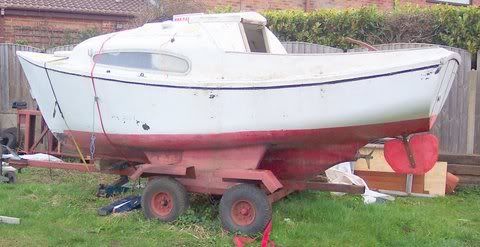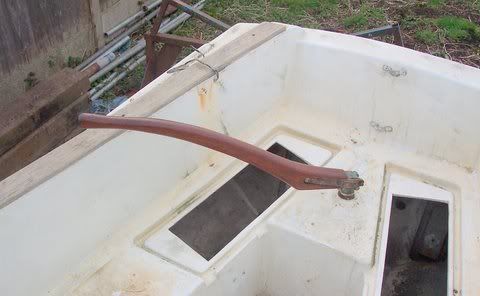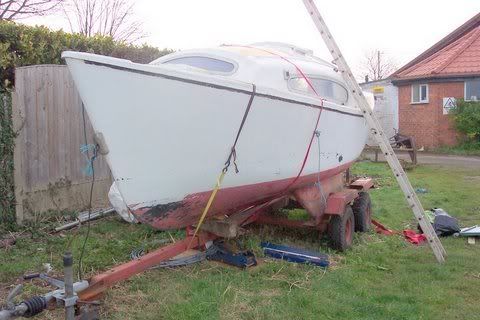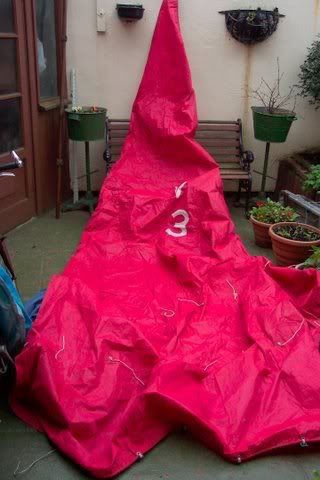This engineless approach to cruising also reintroduces another pleasure, largely forgotten by many sailing people nowadays. It is the enjoyment of that richly thrilling moment when, after a prolonged calm, the sails first lift and swell to a hint of a breeze. The joy of laying aside one's oar to ghost effortlessly forward under drawing canvas was one of the great delights of sailors from Homeric times to the late nineteenth century. We have forgotten it. If we are motoring through a calm, the very special music of that first subtle wind-induced trickle around the bow is invaribly drowned out by the engine's roar.
It appears that we live in a strange age. Not only do some people laugh at the unfamiliar sight of a cruising yacht being rowed, but a few even consider it cause for a rescue attempt. Last summer, while happily sweeping Galadriel out to sea in search of a breeze, I was overtaken by a wouldbe rescue boat that roared up alongside. When I said good morning and politely declined their offer of help, the couple in the poweboat asked med what, precisely, I was doing. I answered that I was rowing.
"Gosh", the young fellow said, "I've never seen that before!"
I love oil lamps and hate the glaring excess of electrics. Even the riding light that my little sloop carries while anchored overnight is a small oil lamp. It can be seen from a distance of half a mile, yet it doesn't so grossly flood the anchorage with glare that one cannot enjoy the delicate glitter of starlight overhead. I'm afraid that my love of fellow yachtsmen fails altogether when their 500-watt masthead lights turn a dark, lonely cove into something like a floodlit supermarket.
My fetish for primitive lamps, however, seems to amaze many sailing people who come aboard. They ask if oil lighting isn't dangerous to one's health. When a friend complained of the smell of kerosene, I replied that, to me, it is the smell of freedom.
The essence of small-boat cruising is freedom from fuss and bother, of which there is plenty in our everyday lives ashore. A tiny, featherweight cruiser is the most trouble-free craft afloat. Many of my sailing friends have a mortal dread of going aground. If their 5-ton fin keelers get hung up on the rocks, disaster is a virtual certainty. By contrast, when Galadriel goes aground (as she does frequently), she sits comfortably on her shallow twin keels in two feet of water. To get her off, I simply jump over the stern and lift her clear.
Everything aboard my boat is crude and simple. If a boom fitting breaks, I just make another. The originals, after all, were merely handwrought bits of steel, rather than fancy items purchased in a yacht chandlery. If I drop a heavy anchor onto a bunk cushion and split it open at the seams, it doesn't matter. It's easy to redo my own rough handstitching. When her bottom needs a coat of antifouling paint, it is a simple matter to paddle her over to the beach and go gently aground. The cost of upkeep is almost nothing - an essential prerequisite to carefree sailing.
The shallow draft has introduced me to a special cruising pleasure denied to larger, deeper craft. I have discovered that British Columbia's rocky coast abounds in tiny cracks and crannies into which I can paddle my little boat. Inside, in water that may only be a couple of feet deep (and totally dried out at low water), I luxuriate in a private anchorage, while more conventional yachts cluster together in droves in the more usual anchoring spots.
Occasionally, I have watched a larger yacht, at the end of a cruise or a daysail, tacking back and forth in the harbour for an hour while someone tries without success to start the engine. Without power, of course, the owner of a big heavy-displacement vessel dares not to attempt the entry into his berth among the ranks in a crowded marina. My little pocket cruiser, on the other hand, works her way handily under sail into the thightest corner. If she does happen to drift out of control in a cramped spot, a gentle shove with the foot is enough to redirect her miniscule inertia and avoid collision.
Yet a little boat ot good design can be a fine offshore sailor, too, as is evidenced by Shane Acton's circumnavigation of the world in a Caprice class sloop like my own. While he was in Australia, Acton was offered the chance of an unbelievable trade - a new 30-foot ocean cruising yacht in exchange for his intriguing little 18-footer. He turned down the offer.
Like Shane Acton, I own a simple little boat that I know intimately and love dearly. It would be sheer folly ever to exchange her for the illusory attractions of something grander.
Philip Teece







